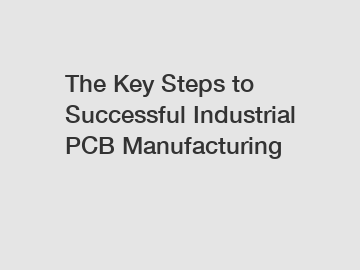The Key Steps to Successful Industrial PCB Manufacturing
In the realm of advanced technology, printed circuit boards (PCBs) are the backbone of countless electronic devices we rely on. From smartphones and computers to medical equipment and automotive systems, PCBs form an integral part of modern industrial manufacturing. However, achieving successful PCB production requires careful planning, a high level of expertise, and adherence to a well-defined set of processes. In this blog, we will explore the key steps involved in the manufacturing of industrial PCBs, elucidating on their significance and the best practices required for success.
Step 1: Design and Schematic Creation.
The journey to a successful PCB assembly begins with a comprehensive and reliable design. Before moving on to manufacturing, skilled engineers meticulously craft the required schematics, ensuring that all electronic components are positioned optimally to guarantee efficient functionality. By leveraging advanced software and tools, they can simulate the behavior of the design, identifying potential issues early on and minimizing costly errors during the manufacturing stage.

Step 2: Prototyping and Material Selection.
Once the design is finalized, prototyping becomes crucial to validate its performance and functionality. During this stage, an experienced team creates a small-scale version of the intended PCB, using representative materials and components. Rigorous testing and analysis allow for improvements and optimizations before moving forward with the full-scale production. Material selection is a critical consideration during prototyping as it affects the overall performance, reliability, and durability of the final product.
Step 3: PCB Fabrication.
The actual PCB fabrication process involves several intricate steps. Firstly, a chosen substrate material, typically fiberglass-reinforced epoxy, is coated with a copper layer. Advanced techniques, like photolithography, selectively remove the unwanted copper from the board, leaving the desired circuit pattern. Multiple layers may be necessary for complex designs, with each layer etched and aligned precisely.
Step 4: Component Assembly.
Once the bare PCB is ready, component assembly takes center stage. Surface Mount Technology (SMT) or Through-Hole Technology (THT) are commonly employed methodologies. SMT allows for compact design and highly automated assembly, while THT offers greater stability with larger components. Automated machines with high precision placements ensure accurate positioning of components, complemented by meticulous soldering techniques to form reliable, electrical connections.
Step 5: Testing and Quality Control.
Quality control is of utmost importance at every stage of PCB manufacturing. Rigorous testing methodologies must be employed to verify the integrity and functionality of the assembled PCBs. A combination of automated testing equipment and manual inspections is used to identify defects or points of failure. The manufactured PCBs should undergo thorough testing for potential short circuits, open connections, and functional capability, ensuring adherence to stringent industry standards.
Step 6: Final Inspection and Packaging.
The last step in PCB manufacturing involves a final inspection and packaging. Trained personnel conduct comprehensive inspections, confirming the integrity of each board and checking for any surface defects, misalignments, or inconsistencies. Following successful inspections, the PCBs are carefully packaged, ready for installation or distribution.
Conclusion:
Successful industrial PCB manufacturing demands expertise, precise execution, and dedication to quality control. From initial design and prototyping to meticulous fabrication, component assembly, testing, and inspection, each step contributes to the overall success of the manufacturing process. By adhering to these key steps and continuously improving techniques, manufacturers can ensure the production of reliable, high-quality PCBs that power the technologies essential to our modern lives.
If you are looking for more details, kindly visit Industrial Control PCB Manufacturer, automotive pcb design , Industrial Control PCB Manufacturer.

Comments
0